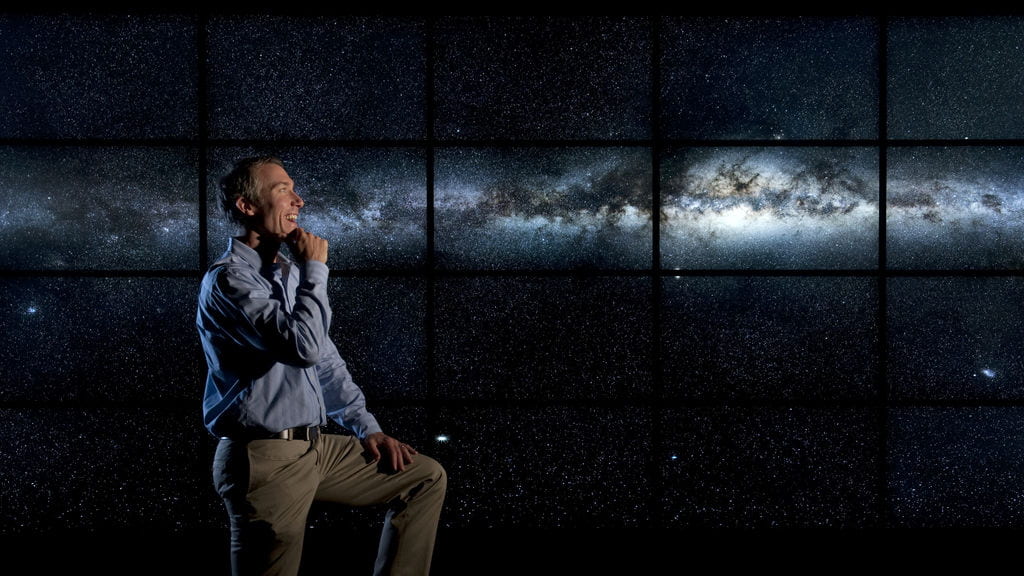UCI cosmologist gives TV audiences a tour of Milky Way
Cosmologist and TV co-host James Bullock helps people see the really big picture — from the Milky Way to the farthest reaches of the universe. He’s one of the “bright young stars” in his field.

James Bullock thinks bigger than most. Growing up in Toledo, Ohio, he
wasn’t particularly fascinated by stars. He believes he first noticed
the night sky at his grandparents’ North Carolina farm, but he’s not
sure. What interests the UC Irvine professor of physics & astronomy
is the whole shebang — the entire universe.
“A cosmologist is interested in the really big-picture questions,
like: What’s the universe made of? How old is it? How did it evolve?” he
says, perched in front of a gigantic photograph of dozens of galaxies
at UCI’s HIPerWall lab. “I’m using detailed observations of the Milky Way and its neighbor galaxies to address these broad questions.”
Despite his cosmic outlook, Bullock, 38, is the kind of personable,
down-to-earth scientist you can throw pretty much any question at — for
instance, does the universe have edges? “As far as we know, there are no
edges. We can’t see the entire universe, because what’s visible has a
finite age,” he responds. “Let me explain what that means.”
To illustrate the phenomenon of time and distance known as light
years, Bullock uses a simple analogy: Imagine you’re standing on planet
Earth looking up, and all the celestial lights get turned off. The sun,
the moon, the stars all fade to total blackness. When the power is
turned back on, nothing changes at first.
After eight minutes, the sun would reappear. “It takes eight minutes
for light to get from the sun to us,” he explains. About four years
later, the nearest star would twinkle again. The brightest star in the
sky would take about nine years. Two and a half million years later, the
Andromeda galaxy would turn up.
“So what we see now is what Andromeda looked like two and a half
million years ago,” says Bullock, reeling off an ever-expanding
progression. “Similarly, if we study galaxies that are farther and
farther away, we’re seeing the universe as it was in a snapshot billions
and billions of years ago. Effectively, what we have is a time-lapse
movie of the universe.”
He’ll put those galactic-tour-guide capabilities to use in a big way
Thursday, Oct. 28, at 9 p.m. and again on Oct. 31, when he co-hosts a National Geographic television special on
what’s new in the Milky Way and other corners of the cosmos.
“The Chinese called it ‘the silver river,'” Bullock says of the
faint, blurry band of stars that contains our home galaxy. “You might
have thought everything about the Milky Way was known, that all the
action was out in the galaxies far, far away. But it turns out that’s
not true. There’s a lot that’s been hidden from our view.”
Just as the sun has planets and Jupiter has rings, the Milky Way is
circled by dwarf galaxies. A decade ago, there were 10 known
mini-galaxies in orbit. In the past five years, with the use of more
powerful telescopes and near-space mapping projects, an additional 15
galaxies have been identified, and more are probably out there.
Other fun facts: The Big Bang theory — which holds that the universe
was created about 14 billion years ago — is accepted by the vast
majority of the world’s astronomers. New asteroids in our solar system
are still being discovered. And, as we peer farther into space, more
planets pop up all the time.
But it’s the void between such objects that lures Bullock and other researchers.
“Dark matter is what really interests me,” he says. “It makes up 80
percent of the universe, and we have no idea what it is. Dark matter is a
fascinating frontier science, because it brings together astronomy,
cosmology and particle physics.”
Scientists do know that it has tremendous gravitational pull, holding
stars and cosmic dust in place like the Earth’s gravity holds you and
your chair in place on the floor.
Bullock laughingly admits he’s a fan of science fiction action
adventures. Asked who his favorite character might be, he names Han
Solo, the Star Wars buccaneer played by Harrison Ford. But then he
reconsiders. Dr. Spock of Star Trek is really tops in his book.
“He’s the smart one,” Bullock says, conceding that he himself wasn’t
all that motivated in school: “I did well at subjects I wanted to do
well at.”
He’s doing well at UCI. Arriving in 2004 after a postdoctoral
fellowship at the Harvard College Observatory, Bullock has risen fast to
become director of the five-campus Southern California Center for Galaxy Evolution.
He was named a fellow of the American Association for the Advancement
of Science in 2008 and even graced the cover of the UCI phone directory
one year — pointing heavenward, of course.
While they rib him about the phone book cover, colleagues aren’t at
all surprised Bullock was tapped to host the television special.
“James is one of the bright young stars in the field of cosmology,” says William H. Parker, chair of UCI’s Department of Physics & Astronomy. “Not only is he an accomplished scholar, he also has the skill to
communicate to the public the current scientific evidence about the
origin and evolution of the universe. He’s a true master of ‘the big
picture.'”